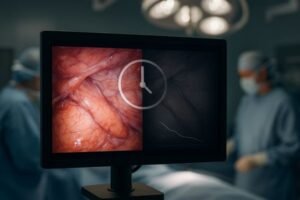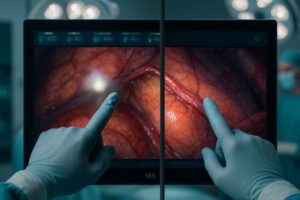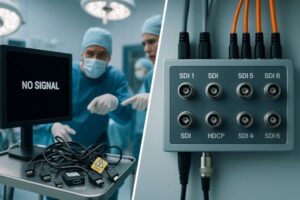Surgeons specializing in Ear, Nose, and Throat (ENT) or ophthalmology work with incredibly delicate and often minute anatomical structures. Suboptimal visualization during these procedures can lead to imprecise movements, prolong surgical times, and potentially compromise patient safety. Finding a display that offers impeccable clarity without overwhelming the highly focused surgical field is a constant challenge, as a monitor that’s too large can obscure the surgeon’s direct view or be difficult to position, while one that’s too small might hide crucial details.
A 22-inch surgical monitor, like our Reshin MS220S, enhances visualization in ENT and ophthalmic surgeries by offering an optimal balance of screen size for focused views of small anatomical targets, Full HD resolution for clear detail, and ergonomic benefits for space-constrained ORs. It provides critical image sharpness and color fidelity essential for these precise procedures without overwhelming the surgeon’s field of view or physical workspace.

As President of Reshin, a specialist monitor manufacturer, I’ve dedicated my career to advancing display technology. I’ve seen how the right monitor can transform delicate surgeries. Let’s explore how the 22-inch screen size specifically benefits these highly specialized fields.
Why is screen size critical for ENT and eye procedures?
In ENT and ophthalmic surgeries, surgeons often strain to see minute details within confined spaces. A wrongly sized screen can obscure these details or create an unergonomic viewing experience, hindering precision.
Screen size is critical because a 22-inch monitor offers an optimal field of view, preventing the visual overwhelm of larger displays on small anatomical targets while being sufficiently large for crucial detail recognition.

My experience in surgical imaging systems1 has consistently shown that "a 22-inch monitor2 offers an optimal field of view for ENT and ophthalmic surgeries, where large displays may overwhelm small, precise anatomical targets." Consider the intricate work within the nasal cavity, the middle ear, or the delicate structures of the eye like the retina or cornea. Surgeons need to see these areas magnified, but a very large screen (e.g., 32 inches or more) placed close to the surgical field can be too dominant, forcing the surgeon to constantly scan a wide area or sit further back, which might not be practical. Conversely, a screen smaller than 19-22 inches might not provide enough visual real estate to comfortably discern all necessary details from endoscopic or microscopic feeds, potentially leading to eye strain or forcing surgeons to lean in excessively. The Reshin MS220S 22-inch FHD Endoscopic Monitor hits a sweet spot. It’s large enough to display complex images with clarity, yet focused enough not to distract from the immediate surgical task. Dr. Amy Chen, with her extensive experience in integrating operating theatre equipment, would appreciate how this tailored screen size supports the precise performance she demands from imaging systems.
How does a 22-inch monitor balance clarity and space efficiency?
ENT and ophthalmic operating rooms or dedicated procedure suites are often compact. Bulky equipment can obstruct movement, block essential OR lights, or impede access to the patient, impacting workflow.
A 22-inch monitor like the Reshin MS220S expertly balances Full HD clarity with space efficiency due to its compact footprint, ensuring easy, ergonomic positioning without blocking light or surgical access.

One of my key insights is that "in narrow OR spaces typical of ophthalmic or ENT departments, a compact 22-inch screen3 ensures easy positioning without blocking light or surgical access." The physical dimensions of our Reshin MS220S are designed with these constraints in mind. It’s trim enough to be easily mounted on flexible articulating arms, existing surgical booms4, or even wall mounts without protruding excessively into the sterile field or the team’s working area. This is particularly vital for ophthalmic surgeries, where the surgeon, microscope, patient, and display are often in very close proximity. Furthermore, as I’ve noted, "compared to bulkier alternatives, a 22-inch monitor mounted on a flexible arm or wall enables better workflow ergonomics and eye-level image alignment during head-level procedures." This allows the surgical team to position the display for optimal viewing angles, reducing neck and back strain during long procedures. This ergonomic advantage5 contributes to surgeon comfort and sustained concentration. For an OEM Purchasing Manager like Alex Müller, whose clients might be equipping smaller European surgical centers, the MS220S offers a reliable, high-performance display that integrates seamlessly into space-conscious system designs.
What role does resolution play in visualizing fine anatomical structures?
Missing subtle tissue changes or misidentifying tiny nerves or vessels in ENT or eye surgery can have significant consequences. Standard, non-medical displays might lack the pixel density and sharpness needed for these critical distinctions.
Full HD (1920×1080) resolution on a 22-inch monitor, such as the Reshin MS220S, provides high pixel density. This is crucial for visualizing the finest nerves, vessels, and delicate tissue layers accurately.

ENT and ophthalmic surgeries fundamentally "rely heavily on real-time endoscopic or microscopic video feeds, which benefit from minimal latency and excellent image sharpness—attributes a 22-inch surgical monitor6 can provide." The Reshin MS220S, with its Full HD (1920×1080 pixels)7 resolution packed into a 22-inch screen, delivers a high pixel density. This means more pixels per inch, resulting in sharper, clearer, and more detailed images. Surgeons can more easily distinguish between minute structures, such as the fine branches of the facial nerve during mastoidectomy, the delicate layers of the retina during vitreoretinal surgery, or subtle textural changes on the tympanic membrane. This high level of detail supports more precise dissection and manipulation of tissues. Low latency is also engineered into our surgical displays, ensuring that the image seen on the monitor is virtually instantaneous with the movement of the endoscope or microscope, which is critical for hand-eye coordination. Dr. Chen’s responsibility for ensuring precise performance of imaging systems directly aligns with these capabilities, as such clarity and responsiveness are non-negotiable for safe and effective surgery.
| Feature | Benefit for Fine Structures in ENT/Ophthalmology | Example Application |
|---|---|---|
| FHD Resolution | Clear delineation of micro-anatomical details | Identifying micro-aneurysms or neovascularization in the retina |
| High Pixel Density | Sharp edges, reduced pixilation for fine lines | Visualizing the ossicular chain or individual nerve fibers |
| Excellent Sharpness | Accurate depth perception and texture rendition | Guiding fine instruments in sinus or middle ear surgery |
| Low Latency | Real-time image feedback for precise movements | Synchronized view during delicate phacoemulsification |
How does anti-reflective technology improve surgical accuracy?
Operating rooms are brightly lit environments. Glare and reflections from ambient lights on a monitor screen can obscure vital details, forcing surgeons to strain their eyes or awkwardly reposition themselves, interrupting focus.
Anti-reflective technology on surgical monitors, including the Reshin MS220S, minimizes glare from strong OR lighting, ensuring a consistently clear and unobstructed view of the surgical field, thereby enhancing focus and accuracy.

The intensive lighting required in operating rooms can easily cause reflections on monitor screens, which can be a significant distraction and impediment to clear visualization. This is particularly problematic in ENT and ophthalmic surgeries where subtle visual cues are paramount. Reshin surgical monitors, including the MS220S, are equipped with advanced anti-reflective (AR) screen surfaces8. This technology effectively diffuses ambient light and minimizes specular reflections, ensuring that the image displayed remains clear, crisp, and easily viewable from various angles and under different lighting conditions. This directly contributes to surgical accuracy9 by allowing surgeons to maintain uninterrupted focus on the intricate details of the surgical site. Reduced glare also leads to less eye fatigue10 during long and demanding procedures. While Dr. Emily Chen’s pain points included "uneven brightness," which is an internal display characteristic, the external issue of glare is equally critical for consistent performance. Our anti-reflective technology ensures the surgeon sees the image as intended by the camera system, without interference from the OR environment. This commitment to optimal visibility is part of Reshin’s dedication to advancing medical display technology.
Why is color fidelity important for ENT and ophthalmic image interpretation?
Misinterpreting tissue color due to poor display fidelity can lead to diagnostic errors or improper surgical decisions. This is especially true in ENT and ophthalmology, where subtle shades and hues can indicate critical physiological states.
Accurate color fidelity on monitors like the Reshin MS220S is vital for distinguishing between healthy and pathological tissue, assessing blood flow and vascularity, and identifying inflammation based on subtle color variations.

My insight that "high-definition imaging on a 22-inch screen11 helps surgeons distinguish subtle color differences in mucosa, retina, or tympanic membrane, which is critical for accurate dissection" underscores the importance of color fidelity12. The Reshin MS220S is calibrated to reproduce colors with high accuracy, ensuring that what the surgeon sees on the screen faithfully represents the actual tissue characteristics captured by the endoscopic or microscopic camera. In ENT, the color of the mucosa can indicate inflammation, infection, or pre-cancerous changes. For example, the pearly white of a cholesteatoma contrasts with the pink of healthy middle ear mucosa. In ophthalmology, subtle variations in the color of the optic disc can signify glaucoma, while changes in retinal vascular coloration can point to diabetic retinopathy or hypertensive changes. Accurate color representation also supports the use of advanced imaging modalities like Narrow Band Imaging (NBI)13, which relies on specific wavelengths of light to enhance visualization of vascular patterns and mucosal morphology. Our skilled R&D team at Reshin, with its deep expertise and over 100 technology patents, ensures that our monitors like the MS220S deliver the color precision demanded by these specialized surgical fields, supporting better diagnostic accuracy and intraoperative decision-making.
Conclusion
The Reshin MS220S 22-inch monitor masterfully provides ENT and ophthalmic surgeons with the ideal synthesis of focused screen size, exceptional Full HD clarity, and precise color accuracy, significantly enhancing visualization for successful patient outcomes.
Looking to upgrade your surgical visualization setup? Contact us at martin@reshinmonitors.com to learn more about how the MS220S can support your clinical precision.
-
Learn about the advancements in surgical imaging systems and their role in enhancing surgical precision and safety. ↩
-
Explore how a 22-inch monitor can enhance surgical precision and reduce distractions during delicate procedures. ↩
-
Explore how a 22-inch screen can enhance surgical workflows and ergonomics, making it a vital tool in operating rooms. ↩
-
Discover the role of surgical booms in modern operating rooms and their impact on workflow and space management. ↩
-
Learn about the importance of ergonomic design in surgery and how it can improve surgeon comfort and efficiency. ↩
-
Explore how surgical monitors enhance precision and clarity in complex surgeries, ensuring better outcomes for patients. ↩
-
Learn about the significance of Full HD resolution in surgical displays for improved image quality and surgical precision. ↩
-
Explore how anti-reflective technology enhances visibility and reduces glare in surgical settings, crucial for precision in operations. ↩
-
Learn about the impact of monitor technology on surgical accuracy, ensuring better outcomes in complex procedures. ↩
-
Discover effective strategies to combat eye fatigue during long surgeries, enhancing surgeon performance and comfort. ↩
-
Explore how high-definition imaging enhances surgical precision and outcomes, crucial for effective procedures. ↩
-
Understanding color fidelity can improve diagnostic accuracy and surgical outcomes, making it essential for medical professionals. ↩
-
Discover how NBI enhances visualization in surgeries, leading to better diagnosis and treatment options. ↩



